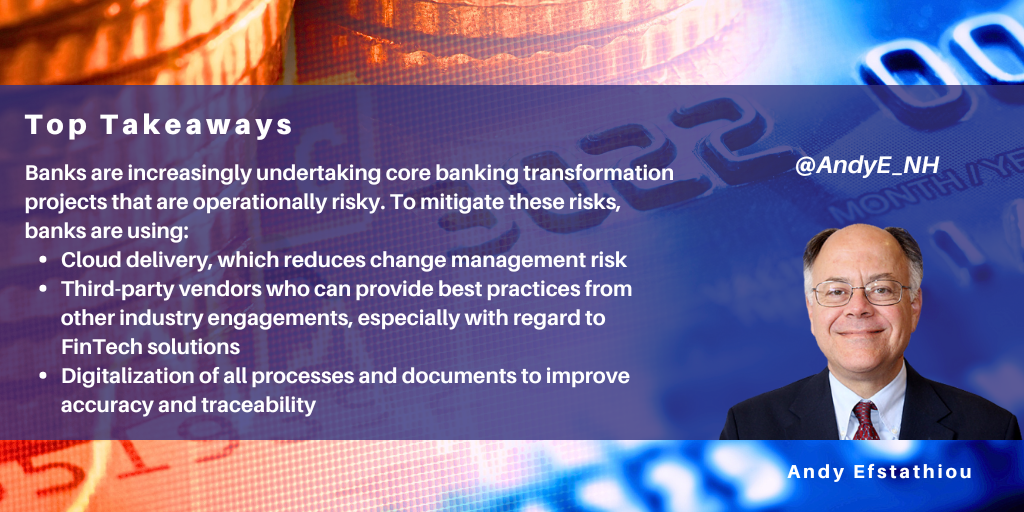posted on Jul 12, 2024 by Andy Efstathiou

Banks are undertaking core banking transformation projects at an accelerating pace. Typically, two-thirds of these transformation projects will fail. Most either fail to implement a new solution altogether, leaving the bank with the original legacy system, or (in the case of a successful implementation), fail to deliver the anticipated value. Some projects, such as those at TSB Bank and Cooperative Bank, cause permanent impairment to the business and become the stuff of legend.
Since the risk of failure is high, why are almost all banks undertaking core platform transformation projects today? Driving the change is a rapidly evolving industry facing multiple challenges:
- Regulatory changes that require real-time transaction processing, open banking businesses, and expanded reporting, especially for fraud and risk
- Changing customer bases resulting from generational change and the banking of previously unbanked consumers
- New bank entrants, both established banks entering new markets and digital bank startups
- Technological change, including cloud, FinTech, AI, and distributed ledger
- High-cost structures requiring greater efficiency to enable those banks to remain viable.
To address these challenges, banks are pursuing three goals with their transformation efforts: developing low-cost access to quality resources, eliminating internal barriers to all corporate resources, and increasing operational efficiency.
Low-cost access to resources
Banks are pursuing the goal of providing low-cost access to resources by building ecosystems of vendors and partners with the help of technology service providers. To succeed, their platforms need to be able to plug in products and services from the ecosystem partners, so the banks are enabling optimum internal technology deployments by modularizing functionality within their platforms.
To do this, banks need a tech/business talent ecosystem to staff transformation projects. Finally, they need an ecosystem of third-party business partners, such as independent investment advisors, loan originators, and data vendors, to set up new businesses quickly and meet open banking requirements.
Eliminating internal barriers to corporate resources
Eliminating internal barriers to corporate resources is being achieved by rearchitecting core banking platforms into a microservices architecture, which enables the bank to change the operational structure from product silo-based to customer-centric. A customer-centric architecture allows the bank to deliver hyper-personalization of services to each customer. Critical to successfully removing internal barriers is changing how data is managed by improving data sourcing, scrubbing, and efficiency. Finally, embedding AI into a platform that can access all relevant data enables customers to shop complex offering portfolios more easily.
Increasing operational efficiency
The third goal of improving efficiency is being achieved by digitalizing all processes and documents. Banks are outsourcing more processes to convert CapEx to OpEx to align revenues and costs better. Processes are being automated with either digitalization or RPA. Where manual execution is still required, banks are implementing AI to reduce manual error, increase the span of control, and deploy consistent use of best practices.
Summary
The biggest challenge to achieving these goals is implementation risk, and the biggest challenge to successful implementation is change management. Banks mostly avoid full replacement strategies in favor of phased modernization or functionality decoupling. These strategies are easier to pursue using cloud delivery, which reduces change management risks by moving technology change management to the cloud provider, leaving business change management as an internal task.
Third-party vendors can provide best practices from other engagements in the industry, which is especially helpful to regional and local banks. These best practices are evolving rapidly as FinTech and cloud technology continue to evolve.
I will publish a market assessment on transforming core banking services in September to delve deeper into this market. It will identify how the market is evolving, what services banks are buying to support their transformation efforts, and the benefits being realized.
